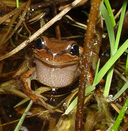|
Description
Litoria ewingii are generally an overall light brown colour, although this may very from a white/grey to a dark brown background. They all have a white stripe along the jawline from the axilla, to at least, below the eye and sometimes to the end of the snout. Most frogs have a lighter patch on the top of the head, extending from between the eyes to the tip of the snout. The belly and throat are usually white or cream and the undersides of the thighs are bright orange. The eardrum (tympanum) is quite distinct and easily visible. The fingers and toes have slightly expanded tips (suckers) that are used for climbing, and webbing is usually absent. These are generally quite small frogs ranging from about 30-50 mm long (SVL). Distribution and Habitat
Country distribution from AmphibiaWeb's database: Australia. Introduced: New Zealand.
Range and population.
From the south-eastern corner of South Australia, east along the south coast of Victoria and into far south-eastern New South Wales. Isolated populations occur along the coast and ranges of central New South Wales. Widely distributed in Tasmania.The extent of occurrence of the species is approximately 311900 km2Widespread and common.
In New Zealand it has now become quite widespread over all of the South Island and most of the southern and central North Island, with the odd record in the northern areas.
Life History, Abundance, Activity, and Special Behaviors
Various habitats from alpine to semi-arid shrubland, but most common in flooded grassland or marshes. Can also be found in suburban gardens. Common in both temporary and permanent water.
Breeding occurs at any time of year with peaks in spring and autumn. Males call from the ground or in low vegetation at the water's edge or in water on floating vegetation. About 500 - 700 eggs are laid in small clumps attached to submerged vegetation. In still water in ponds, dams, lakes, streamside ponds and flooded roadside ditches. Metamorphosis takes 6-7 months.
Trends and Threats
Threats: Water pollution where the species occurs in urban areas.
Relation to Humans
This species is a popular species with children and many tadpoles are raised to the froglet stage. Much of its distribution in New Zealand can be correlated with deliberate releases by humans of the newly metamorphosed froglets.
References
Barker, J., Grigg, G. C., and Tyler, M. J. (1995). A Field Guide to Australian Frogs. Surrey Beatty and Sons, New South Wales.
Cogger, H.G. (1992). Reptiles and Amphibians of Australia. Reed Books, New South Wales.
Hero, J.-M., Littlejohn, M., and Marantelli, G. (1991). Frogwatch Field Guide to Victorian Frogs. Department of Conservation and Environment, Victoria.
Martin, A. A., and Littlejohn, M. J. (1982). Tasmanian Amphibians. University of Tasmania, Hobart.
Originally submitted by: Jean-Marc Hero and Phil Bishop (first posted 2002-08-06)
Edited by: Joyce Gross (2021-03-18)Species Account Citation: AmphibiaWeb 2021 Litoria ewingii: Whistling Tree Frog <https://amphibiaweb.org/species/1247> University of California, Berkeley, CA, USA. Accessed Jun 1, 2025.
Feedback or comments about this page.
Citation: AmphibiaWeb. 2025. <https://amphibiaweb.org> University of California, Berkeley, CA, USA. Accessed 1 Jun 2025.
AmphibiaWeb's policy on data use.
| 




 Map of Life
Map of Life